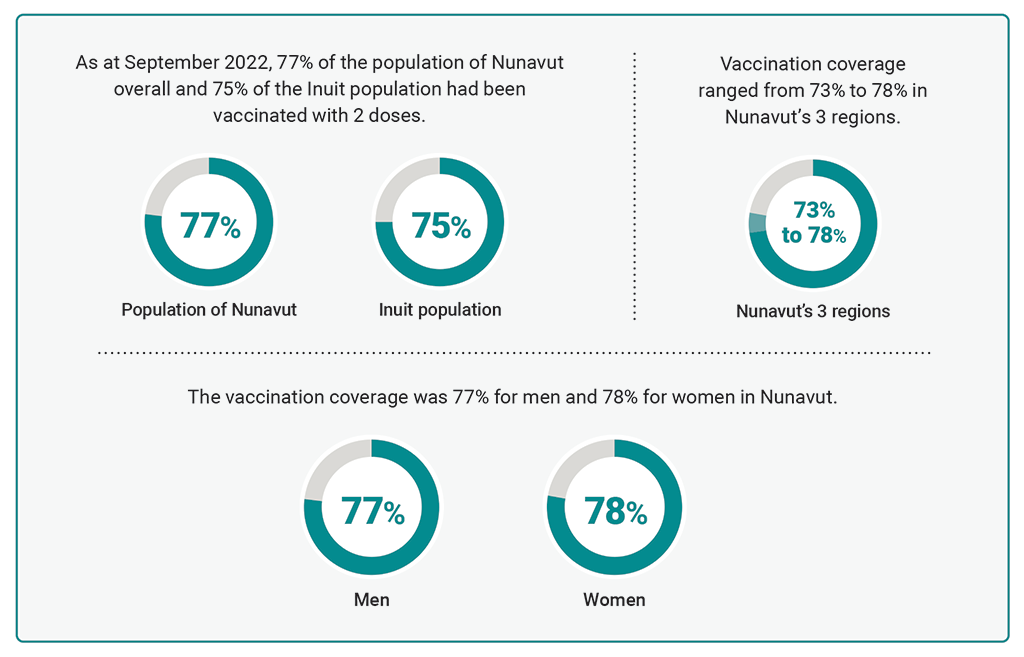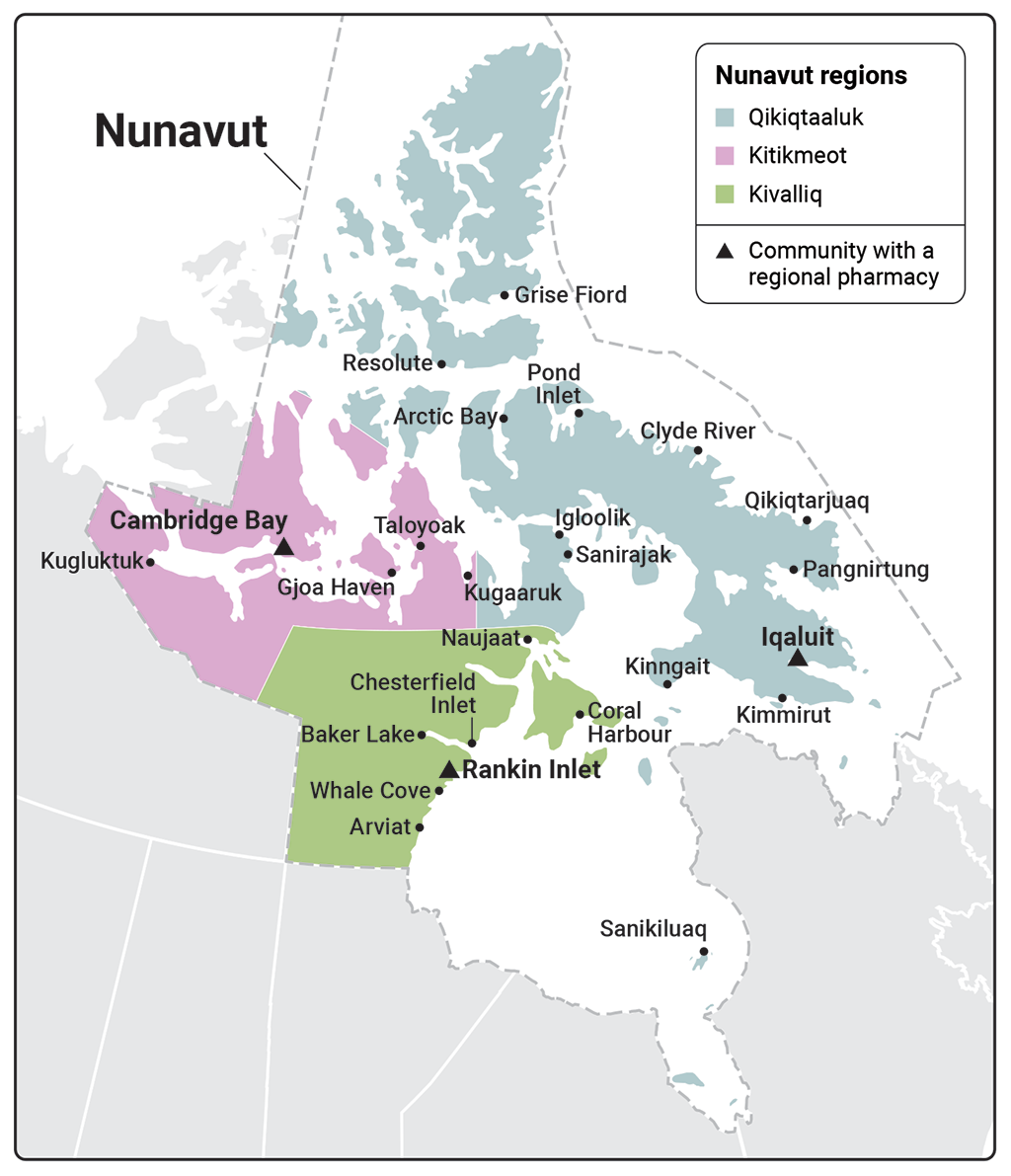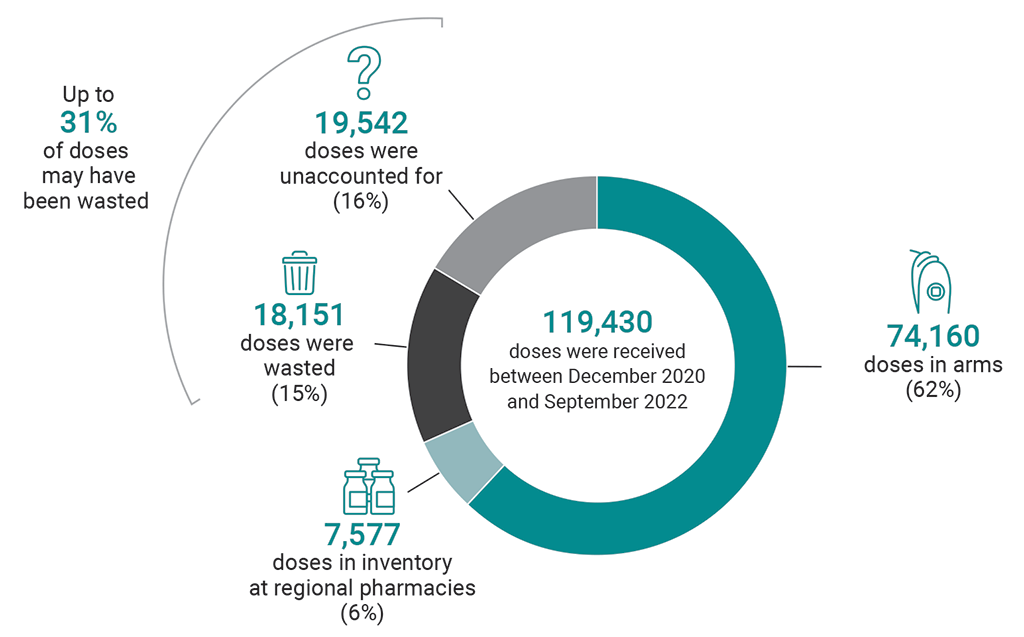2023 Report of the Auditor General of Canada to the Legislative Assembly of Nunavut
COVID-19 Vaccines in Nunavut
At a Glance
Overall, the 3 departments responsible for the COVID‑19 vaccine rollout across Nunavut worked together and with community stakeholders to quickly give all Nunavummiut access to the vaccines. On average, it took the departments 2 weeks to deliver vaccines to communities from the time the vaccines arrived in the territory. This success was achieved despite significant logistical challenges in reaching remote and isolated communities and despite staff and nursing shortages.
The vaccine rollout relied on a small number of health care workers and regional and territorial staff whose work was aided by their familiarity with the territory’s unique context. However, their efforts were complicated by the lack of a pandemic plan to guide their vaccination efforts and by ineffective and inefficient monitoring and reporting systems. For example, the absence of an inventory management system meant that the department could not account for more than 19,500 vaccine doses (16%). This also meant that the department’s reported wastage of 15% of total vaccines is likely inaccurate and may be more than double what was reported. The Government of Nunavut needs to address the issues related to its information systems—including inventory management—to improve health care service delivery, to reduce the burden on an overstretched workforce, and to strengthen its response to future pandemics and mass immunization efforts.
Key facts and findings
- COVID‑19 vaccine doses were delivered and administered in a timely manner.
- The departments made efforts to remove barriers and prioritized vulnerable populations for vaccination.
- Responsible departments worked together and collaborated with community and Inuit stakeholders.
- The Department of Health did not have a pandemic plan in place to guide its COVID‑19 vaccination efforts.
- The Department of Health lacked the information systems to track, monitor, and report on key components of the vaccine rollout, such as vaccine inventory, wastage, adverse events, and training.
- Because of the absence of an inventory management system for tracking vaccines, the department could not account for 19,542 doses (16%).
- The Department of Health reported wastage of 15%, but the percentage could be as high as 31% when the known wastage is combined with the doses that were unaccounted for.

Text version
These pie charts show the vaccination coverage in Nunavut as at September 2022:
- 77% of the population of Nunavut overall and 75% of the Inuit population had been vaccinated with 2 doses.
- Vaccination coverage ranged from 73% to 78% in Nunavut’s 3 regions.
- The vaccination coverage was 77% for men and 78% for women in Nunavut.
Why we did this audit
- The COVID‑19 pandemic was the most severe outbreak of infectious disease in more than a century. Therefore, it is crucial to identify areas for improvement, capture lessons learned, and highlight successful strategies to support future public health emergency efforts, including support for health care workers.
- Timely and equitable access to COVID‑19 vaccines was needed to help reduce the risk to Nunavummiut of serious illness, hospitalization, and death from COVID-19. The provision of the COVID-19 vaccines was an important public health priority to minimize the burden on Nunavut’s health care system.
Highlights of our recommendations
- As the Department of Health agreed to do in 2017, it should put in place systems to track the completion of orientation and training programs for health care staff, monitor whether their licences and certifications are up to date, and provide regular reports of overdue training and expired licences or certifications.
- To improve inventory management at the territorial, regional, and community levels and to lighten the burden on its health care workers, the Department of Health should implement a digital inventory system capable of tracking medications, including vaccines and related medical supplies, from their entry into the territory to their administration or use. This should include the ability to track the movement of medications within the territory, lot numbers, expiry dates, usage, and wastage.
Please see the full report to read our complete findings, analysis, recommendations and the audited organizations’ responses.
Exhibit highlights
Key dates in Nunavut’s COVID‑19 vaccine rollout
| 25 January 2020 | The first case of COVID‑19 is confirmed in Canada. |
|---|---|
| 11 March 2020 | The World Health Organization declares the global outbreak of COVID‑19 to be a pandemic. |
| 20 March 2020 | The Government of Nunavut’s Minister of Health declares a state of public health emergency under section 40 of the Consolidation of Public Health Act. |
| 6 November 2020 | The first community case of COVID‑19 is confirmed in Nunavut. |
| 9 December 2020 | Health Canada authorizes the first COVID‑19 vaccine. |
| Mid‑December 2020 | Canada receives its first shipments of COVID‑19 vaccine doses. |
| 30 December 2020 | Nunavut receives its first shipments of COVID‑19 vaccine doses. |
| 6 January 2021 | Vaccination begins in Nunavut for people aged 18 years and older. |
| 15 June 2021 | Vaccination begins in Nunavut for people aged 12 years and older. |
| 30 November 2021 | Vaccination begins in Nunavut for people aged 5 years and older. |
| 11 April 2022 | Nunavut’s state of public health emergency officially ends. |
Source: The World Health Organization and various sources of the Government of Canada and the Government of Nunavut
Nunavut’s 25 communities are dispersed across a vast area covering one fifth of Canada

Source: Based on information from the Government of Nunavut’s Department of Health
Text version
This map shows Nunavut’s 3 regions and 25 communities. One community in each region has a regional pharmacy.
Nunavut’s largest region is Qikiqtaaluk, which makes up the territory’s eastern half and its northernmost and southernmost areas. This region contains 13 of the territory’s 25 communities. In alphabetical order, they are Arctic Bay, Clyde River, Grise Fiord, Igloolik, Iqaluit, Kimmirut, Kinngait, Pangnirtung, Pond Inlet, Qikiqtarjuaq, Resolute, Sanikiluaq, and Sanirajak. The community with a regional pharmacy is Iqaluit.
The other 2 regions make up the territory’s western half. They are Kitikmeot to the north and Kivalliq to the south.
The region of Kitikmeot contains 5 of the territory’s communities. In alphabetical order, they are Cambridge Bay, Gjoa Haven, Kugaaruk, Kugluktuk, and Taloyoak. The community with a regional pharmacy is Cambridge Bay.
The region of Kivalliq contains the remaining 7 of the territory’s communities. In alphabetical order, they are Arviat, Baker Lake, Chesterfield Inlet, Coral Harbour, Naujaat, Rankin Inlet, and Whale Cove. The community with a regional pharmacy is Rankin Inlet.
As at September 2022, up to 31% of doses may have been wasted

Note: Because of rounding, percentages do not total 100.
Source: Based on information from the Public Health Agency of Canada and the Government of Nunavut’s Department of Health
Text version
This pie chart shows the breakdown of the 119,430 vaccine doses that Nunavut received between December 2020 and September 2022.
Up to 31% of the doses that were received may have been wasted. This consisted of the following:
- 19,542 doses that were unaccounted for, which represented 16% of the doses that were received
- 18,151 doses that were wasted, which represented 15% of the doses that were received
The remaining number of doses that were received consisted of the following:
- 74,160 doses in arms, which represented 62% of the doses that were received
- 7,577 doses in inventory at regional pharmacies, which represented 6% of the doses that were received
Note: Because of rounding, percentages do not total 100.
Infographic

Text version
COVID-19 vaccines in Nunavut
The rollout of COVID‑19 vaccines in Nunavut was timely and equitable despite complex logistical challenges.
Highlights of the rollout are as follows:
- There were 2 weeks between the arrival of vaccines and immunization.
- 77% of the Nunavut population has received 2 doses (as of September 2022).
- Nunavut was one of the first Canadian jurisdictions to receive COVID‑19 vaccines.
- 75% of the Inuit population has received 2 doses (as of September 2022).
At the end of 2020, there was the 1st delivery of vaccine doses to Nunavut.
The following took place during the rollout:
- the training of nurses
- mass vaccination clinics in Nunavut’s 3 regions
- the targeting of vulnerable populations, such as Elders’ homes, correctional facilities, and shelters
- the removal of barriers, through interpreters, communications in Inuktut, and mobile health units
As of September 2022, vaccination coverage ranged from 73% to 78% in Nunavut’s 3 regions and 25 fly‑in communities.
There was good collaboration between the Government of Nunavut and Inuit organizations and communities.
Information systems need to be put in place to support health care service delivery for Nunavummiut.
Related information
Entities
Tabling date
- 30 May 2023
Related audits
- 2022 Reports of the Auditor General of Canada
Report 9—COVID‑19 Vaccines - 2021 Reports of the Auditor General of Canada to the Parliament of Canada
Report 8—Pandemic Preparedness, Surveillance, and Border Control Measures
